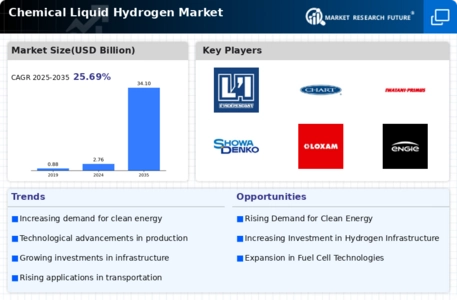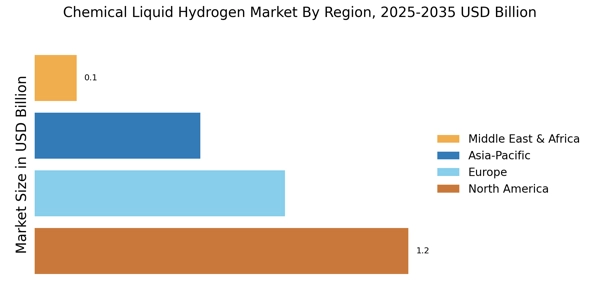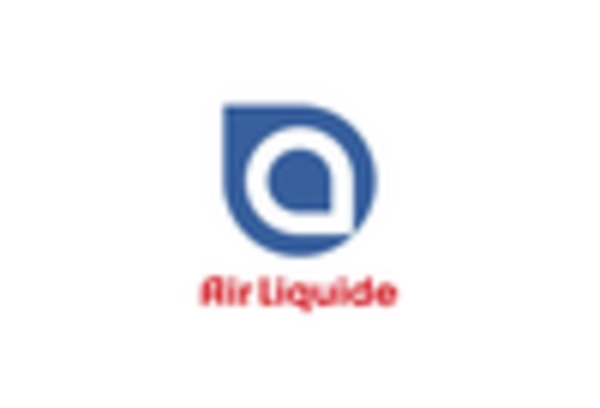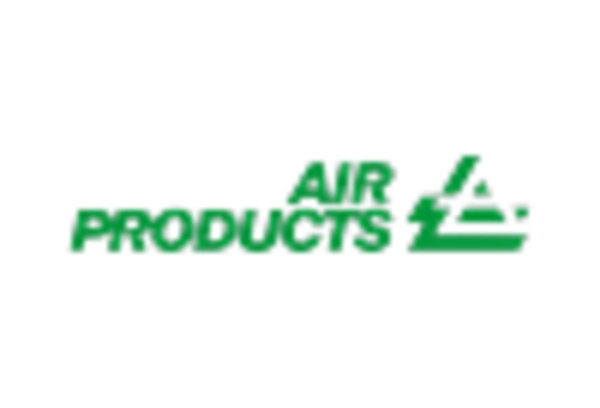Rising Demand for Energy Storage Solutions
The Chemical Liquid Hydrogen Market is also benefiting from the rising demand for effective energy storage solutions. As renewable energy sources such as wind and solar become more prevalent, the need for efficient storage systems to manage energy supply and demand is critical. Liquid hydrogen presents a viable solution due to its high energy density and ability to store large amounts of energy for extended periods. This characteristic makes it an attractive option for balancing energy loads and ensuring a stable energy supply. The increasing focus on energy storage technologies is likely to drive growth in the Chemical Liquid Hydrogen Market, as stakeholders seek to integrate hydrogen solutions into their energy management strategies.
Increasing Adoption of Hydrogen as a Fuel Source
The Chemical Liquid Hydrogen Market is experiencing a notable shift towards the adoption of hydrogen as a primary fuel source. This trend is driven by the increasing need for sustainable energy solutions across various sectors, including transportation and industrial applications. Hydrogen, particularly in its liquid form, offers a high energy density, making it an attractive option for long-haul transportation. According to recent data, the demand for hydrogen fuel is projected to grow significantly, with estimates suggesting a compound annual growth rate of over 15% in the coming years. This surge in demand is likely to propel the Chemical Liquid Hydrogen Market forward, as companies seek to capitalize on the benefits of hydrogen fuel in reducing carbon emissions and enhancing energy efficiency.
Technological Innovations in Hydrogen Production
Technological advancements in hydrogen production methods are significantly influencing the Chemical Liquid Hydrogen Market. Innovations such as electrolysis, steam methane reforming, and biomass gasification are enhancing the efficiency and sustainability of hydrogen production. These technologies are becoming more cost-effective, which is crucial for the widespread adoption of hydrogen as a clean energy source. Recent studies indicate that the cost of producing hydrogen through electrolysis is expected to decrease by approximately 30% over the next decade. This reduction in production costs could lead to a substantial increase in the availability of chemical liquid hydrogen, thereby stimulating growth within the Chemical Liquid Hydrogen Market.
Growing Interest in Hydrogen Fuel Cells for Transportation
The Chemical Liquid Hydrogen Market is witnessing a surge in interest surrounding hydrogen fuel cells, particularly in the transportation sector. Fuel cell vehicles (FCVs) are gaining traction as a clean alternative to traditional fossil fuel-powered vehicles. The advantages of hydrogen fuel cells, such as quick refueling times and longer driving ranges, are appealing to consumers and manufacturers alike. Recent market analyses suggest that the number of hydrogen fuel cell vehicles is expected to increase significantly, with projections indicating a market penetration rate of over 10% by 2030. This growing interest in hydrogen fuel cells is likely to enhance the demand for chemical liquid hydrogen, further propelling the Chemical Liquid Hydrogen Market.
Government Initiatives and Policies Supporting Hydrogen Economy
The Chemical Liquid Hydrogen Market is being bolstered by various government initiatives aimed at promoting a hydrogen economy. Numerous countries have implemented policies that encourage the development and utilization of hydrogen technologies, including financial incentives and research grants. For instance, investments in hydrogen infrastructure are on the rise, with governments allocating substantial budgets to support hydrogen production, storage, and distribution. These initiatives not only aim to reduce greenhouse gas emissions but also seek to enhance energy security. As a result, the Chemical Liquid Hydrogen Market is likely to benefit from increased funding and support, fostering innovation and accelerating the transition to a hydrogen-based energy system.


















Leave a Comment